Iraqi dinar
The Iraqi dinar (Arabic pronunciation: [diːˈnɑːr]) (Arabic: دينار, (sign: د.ع; code: IQD) is the currency of Iraq. It is issued by the Central Bank of Iraq and is subdivided into 1,000 fils (فلس), although inflation has rendered the fils obsolete since 1990.
| Iraqi dinar | |
|---|---|
| دينار عراقي (Arabic) دیناری عێراقی (Kurdish) | |
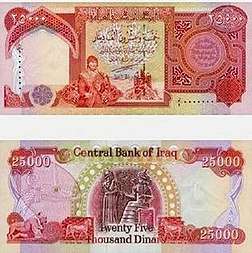 25,000-dinars banknote from the 2003 series | |
| ISO 4217 | |
| Code | IQD |
| Denominations | |
| Subunit | |
| 1⁄1,000 | fils |
| Symbol | د.ع |
| Banknotes | |
| Freq. used | 250, 500, 1,000, 5,000, 25,000 dinars |
| Rarely used | 10000, 50000 dinars |
| Demographics | |
| User(s) | |
| Issuance | |
| Central bank | Central Bank of Iraq |
| Website | www |
| Valuation | |
| Inflation | 1.79% |
| Source | Central Bank of Iraq, May 2015. |
History
The dinar was introduced into circulation in 1932, replacing the Indian rupee, which had been the official currency since the British occupation of the country in World War I, at a rate of 1 dinar = 11 rupees. The dinar was pegged at par with the British pound until 1959 when, without changing its value, the peg was switched to the United States dollar at the rate of 1 dinar = 2.80 dollars. By not following the devaluations of the US currency in 1971 and 1973, the dinar rose to a value of US$3.3778, before a 5 percent devaluation reduced the value of the dinar to US$3.2169, a rate which remained until the Gulf War, although in late 1989, the black market rate was reported at five to six times higher than the official rate.[1]
After the Gulf War in 1991, due to UN sanctions, the previously used Swiss printing method was no longer available so new, inferior quality, notes were produced. The previously produced notes became known as the Swiss dinar and continued to circulate in the Kurdish region of Iraq. Due to sanctions placed on Iraq by the United States and the international community along with excessive government printing, the new dinar notes devalued quickly. By late 1995, US$1 was valued at 3,000 dinars in the black market.
Recent developments
After Saddam Hussein was deposed in the 2003 invasion of Iraq, the Iraqi Governing Council and the Office for Reconstruction and Humanitarian Assistance began printing more Saddam dinar notes as a stopgap measure to maintain the money supply until new currency could be introduced.
Between 15 October 2003 and 15 January 2004, the Coalition Provisional Authority issued new Iraqi dinar coins and notes, with the notes printed by the British security printing firm De La Rue using modern anti-forgery techniques to "create a single unified currency that is used throughout all of Iraq and will also make money more convenient to use in people's everyday lives". Multiple trillions of dinars were then shipped to Iraq and secured in the CBI for distribution to the population in exchange for the 'Saddam dinar'.[2] Old banknotes were exchanged for new at a one-to-one rate, except for the Swiss dinars, which were exchanged at a rate of 150 new dinars for one Swiss dinar.
There is considerable confusion (perhaps intentional on the part of dinar sellers) around the role of the International Monetary Fund in Iraq. The IMF as part of the rebuilding of Iraq is monitoring their finances and for this purpose uses a single rate (not a sell/buy) of 1170 dinars per dollar. This "program rate"[3] is used for calculations in the IMF monitoring program and is not a rate imposed on Iraq by the IMF. For a wider history surrounding currency in the region, see British currency in the Middle East.
Use in speculation and fraud since the Iraq war (2003–present)
Since Iraq has few exports other than oil, which is sold in dollars, there is little international demand for dinars, resulting in an extremely high exchange rate compared with other currencies: on 2 March 2019, the Central Bank's indicative exchange rate was 1,190 dinars for one dollar, or 1,355 dinars for one euro.[4]
However, the downfall of Saddam Hussein resulted in the development of a multi-million-dollar industry involving the sale of dinars to speculators. Such exchange services and companies sell dinars at an inflated price, pushing the idea that the dinar would sharply increase in value to a profitable exchange rate some time in the future, instead of being redenominated. This activity can be either a legitimate service to currency speculators, or foreign exchange fraud: at least one major such currency exchange provider was convicted of fraud involving the dinar.[5] This trade revived after the election of Donald Trump in November 2016, with many buyers believing that Trump would cause the value of the dinar to increase sharply.[6]
In 2014, Keith Woodwell (director of the Utah Division of Securities) and Mike Rothschild (writer for Skeptoid blog) stated that the speculation over the Iraqi dinar originated from a misunderstanding of why the value of the Kuwaiti dinar recovered after the First Gulf War, leading to an assumption that the Iraqi dinar would follow suit after the fall of Saddam: Woodwell and Rothschild noted substantial differences in economic and political stability between Iraq and Kuwait, with Iraq facing pervasive sectarian violence amid near-total reliance on oil exports.[7][8]
In response to the growing concerns about fraud and scams related to investment in the Iraqi dinar, State agencies such as Washington State,[9] Utah,[10] Oklahoma,[11] Alabama[12] and others issued statements and releases warning potential investors. Further alerts were issued by news agencies.[13]
These alerts usually warn potential investors that there is no place outside Iraq to exchange the dinar, that they are typically sold by dealers at inflated prices, and that there is little evidence to substantiate the claims of significant appreciation of their investment due to revaluation of the currency.
In February 2014, the Better Business Bureau included investing in the dinar as one of the ten most notable scams in 2013.[14] There has also been a book written on the subject.[15]
Coins
Coins were introduced in 1931 and 1932 in denominations of round 1, and 2 fils in bronze, and scalloped 4, and 10, fils in nickel. 20, 50, and 200 fils were 50% silver. The 200 fils coin is also known as a rial. Bronze substituted nickel in the 5 and 10 fils from 1938 to 1943 during the World War II period and reverted to nickel in 1953. Silver 100 fils coins were also introduced in 1953. These coins first depicted King Faisal I from 1931 to 1933, King Ghazi from 1938, and King Faisal II from 1943 until the end of the kingdom.
Following the establishment of the Iraqi Republic, a new series of coins was introduced in denominations of 1, 5, 10, 25, 50, and 100 fils, with the 25, 50, and 100 fils in silver until 1969. In this series an allegorical sun replaced the image of the king, shapes and sizes remained the same with the exception of the 1 fil which was decagon shaped. This image was then replaced by three palms in 1968. In 1970, 250 fils pieces were introduced, followed by 500 fils and 1 dinar coins in 1982. A number of the coins for 1982 were a commemorative series celebrating Babylonian achievements. During this period, many of the coins were identified by their shape due to being made of similar composition metals, as from 1980 onward 250 fils were octagonal, 500 fils square, and 1 dinar decagon shaped. Coin production ceased after 1990 due to the emergency conditions generated by the Gulf War and international sanctions.
In 2004, a new series of coins were issued in denominations of 25, 50 and 100 dinars and were struck in bronze, brass, and nickel-plated steel respectively. They are sparse in design and depict an abstract map of Iraq and the main rivers.
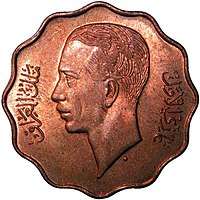 10 fils 1938, obverse
10 fils 1938, obverse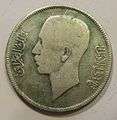 50 fils 1938, obverse
50 fils 1938, obverse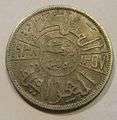 50 fils 1938, reverse
50 fils 1938, reverse
| Value | Diameter | Weight | Composition | Obverse | Reverse |
|---|---|---|---|---|---|
| 25 dinars | 17.4 mm[16] | 2.5 g[16] | Copper-plated steel[16] | Inscriptions: "Central Bank of Iraq" and "25 dinars" | Outline map of Iraq with the two rivers |
| 50 dinars | 22 mm[16] | 4.34 g[16] | Brass-plated steel[16] | Inscriptions: "Central Bank of Iraq" and "50 dinars" | Outline map of Iraq with the two rivers |
| 100 dinars | 22 mm[16] | 4.3 g[16] | Stainless steel[16] | Inscriptions: "Central Bank of Iraq" and "100 dinars" | Outline map of Iraq with the two rivers |
Banknotes
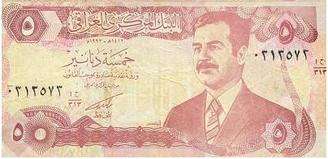
In 16 March 1932, banknotes were issued by the government in denominations of 1⁄4, 1⁄2, 1, 5, 10 and 100 dinars. The notes were printed in the United Kingdom by Bradbury, Wilkinson & Co.[17] From 1932 to 1947, the banknotes were issued by the Iraqi currency board for the government of Iraq and banknotes were convertible into pound sterling. From 1947, the banknotes were issued by the National Bank of Iraq, then after 1954 by the Central Bank of Iraq.
100 dinars notes ceased production in the 1940s, however, the same denominations were used until 1978, when 25 dinars notes were introduced. In 1991, 50 dinars were introduced and 100 dinars reintroduced, followed in 1995 by 250 dinar notes and 10,000 dinars notes in 2002.
Banknotes that were issued between 1990 and October 2003, along with a 25-dinar note issued in 1986, bear an idealized engraving of former Iraqi President Saddam Hussein. Following the 1991 Gulf War, Iraq's currency was printed both locally and in China, using poor grade wood pulp paper (rather than cotton or linen) and inferior quality lithography (some notes were reputedly printed on presses designed for printing newspapers).
The primitive printing techniques resulted in a limitless variety in coloration and detail, one layer of the printing would be too faint while another would be too dark. Counterfeit banknotes often appeared to be of better quality than real notes. Some notes were very poorly cut, and some notes even lacked serial numbers. Despite the collapse in the value of the Iraqi dinar, the highest denomination printed until 2002 was 250 dinars. In 2002, the Central Bank of Iraq issued a 10,000-dinars banknote to be used for "larger, and inter-bank transactions". This note was rarely accepted in practice due to fears of looting and counterfeiting. This forced people to carry around stacks of 250-dinars notes for everyday use. The other, smaller bills were so worthless that they largely fell into disuse. This situation meant that Iraq, for the most part, had only one denomination of banknote in wide circulation.
Currency printed before the Gulf War was often called the Swiss dinar. It got its name from the Swiss printing technology that produced banknotes of a considerably higher quality than those later produced under the economic sanctions that were imposed after the first Gulf War. After a change-over period, this currency was disendorsed by the Iraqi government. However, this old currency still circulated in the Kurdish regions of Iraq until it was replaced with the new dinar after the second Gulf War. During this time the Swiss dinar retained its value, whilst the new currency consistently lost value at sometimes 30 percent per annum.
In 2003, new banknotes were issued consisting of six denominations: 50, 250, 1,000, 5,000, 10,000, and 25,000 dinars. The notes were similar in design to notes issued by the Central Bank of Iraq in the 1970s and 1980s. A 500 dinars note was issued a year later, in October 2004. In the Kurdish regions of Iraq, the 50 dinar note is not in circulation.
In March 2014, the Central Bank of Iraq began replacing banknotes with anti-counterfeiting enhanced versions that include SPARK optical security features, scanner readable guarantee threads in addition to braille embossing to assist vision-impaired persons.[18][19][20][21]
In February 2015, the Central Bank of Iraq announced on their website the removal of the 50-dinar notes from circulation on 30 April 2015. Citizens holding these banknotes were immediately advised to redeem them at their nearest bank for the 250 and higher denomination dinar notes at a one-to-one rate at no charge.[22]
In November 2015, the Central Bank of Iraq announced the introduction of a new 50,000-dinar banknote. This is the first new denomination banknote since the new series was first issued in 2003, and also the largest ever printed by the CBI. The current notes no longer depict an image of former Iraqi president Saddam Hussein and now feature inscriptions in both Arabic and Kurdish.[23] The banknotes are printed using new security features from Giesecke & Devrient & De La Rue and measure 156 × 65 mm. They feature an outline map of Iraq showing the Euphrates & Tigris rivers as well as the Great Mosque of Samarra.
Kingdom of Iraq dinar series (1932–1958)
| Kingdom Dinar Series | |||||
|---|---|---|---|---|---|
| Image | Value | Main Color | Description | ||
| Obverse | Reverse | Obverse | Reverse | ||
 |
 |
1⁄4 dinar
(1932) |
Green and black | King Faisal I | |
 |
 |
1⁄2 dinar
(1932) |
Red and black | King Faisal I | |
 |
 |
1 dinar
(1932) |
Black and dark brown | King Faisal I | |
 |
 |
1 dinar
(1939) |
Green and dark brown | King Faisal II as a child | Kingdom Coat of arms with 1 dinar written inside |
 |
 |
5 dinars
(1932) |
Red and black | King Faisal I | |
 |
 |
10 dinars
(1932) |
Dark brown and black | King Faisal I | |
 |
 |
100 dinars
(1932) |
Yellow red and black | King Faisal I | |
 |
 |
100 dinars
(1939) |
Yellow Green and black | King Faisal II as a child | |
Swiss dinar series (1979–1986)
| Swiss Dinar Series | |||
|---|---|---|---|
| Value | Main Color | Description | |
| Obverse | Reverse | ||
| 1⁄4 dinar | Green | silo of basra | Date palms |
| 1⁄2 dinar | Brown | the Arabic astrolabe | Spiral minaret of the Great Mosque of Samarra |
| 1 dinar | Blue-green | A gold dinar coin | Mustansiriya Madrasah |
| 5 dinars | Brown-violet and deep blue | Gelî Ali Beg and its waterfall | Al-Ukhaidir Fortress |
| 10 dinars | Purple on blue and violet | Abu Ali Hasan Ibn al-Haitham | Al-manara al-hadba fi al-Mawsil (the hunchbacked tower of the Great Mosque of al-Nuri) |
| 25 dinars | Green and brown | Horses | Abbasid Palace |
| 25 dinars (1986) | Brown, green and black on blue | Saddam Hussein with Battle of al-Qādisiyyah in background | Al-Shaheed Monument |
1990–2003 series
| 1990–2002 Series | |||||
|---|---|---|---|---|---|
| Image | Value | Main Color | Description | ||
| Obverse | Reverse | Obverse | Reverse | ||
| 1⁄4 dinar (1993) | Green | Palm trees | Al-Bab al-wastaniy li-sur Baghdad (middle gate of the town wall of Baghdad) | ||
| 1⁄2 dinar (1993) | Violet | Astrolabe | Great Mosque of Samarra | ||
| 1 dinar (1992) | Pink and green | A gold dinar coin | Mustansiriya Madrasah | ||
| 5 dinars (1990; not issued) | Light red and pink | Saddam Hussein, buildings at Hatra, statuette of Ur-Nammu (2111 to 2094 BC), King of Ur | House (Mudhif) built by the marsh Arabs, or the Ma’dan, in southern Iraq, frieze from the Sumero-Akkadian period, eagle, found at Hatra, Sumerian weight stone ("duck weight"), golden head of a bull, decorating the front of a lyre covered with inlays | ||
| 5 dinars (1992) | Red | Saddam Hussein | The Monument to the Unknown Soldier, King Hammurabi with the sun god Shamash | ||
| 10 dinars (1990; not issued) | Blue | Saddam Hussein, palm trees, scene of the Tigris River | King Ashur-bani-pal galloping forward with bow and arrow, 645–635 BC | ||
| 10 dinars (1992) | Blue-green | Saddam Hussein and Ishtar gate | Lamassu, Assyrian carving of a winged bull | ||
| 25 dinars (1990) | Green | Horses | Abbasid Palace | ||
| 25 dinars (1986) | Green-brown | Saddam Hussein & Battle of Qadisiyah | Al-Shaheed Monument | ||
| 25 dinars (2001) | Green | Saddam Hussein | Ishtar gate | ||
| 50 dinars (1991) | Pink and green | Saddam Hussein | Great Mosque of Samarra | ||
| 50 dinars (1994) | Brown and blue | Saddam Hussein and the Al-Shaheed Monument | Saddam Bridge | ||
| 100 dinars (1991) | Green and purple | Saddam Hussein | Hands of Victory (Swords of Qādisīyah) | ||
| 100 dinars (1994) | Blue | Saddam Hussein and the Hisn al-Ukhaydir (Al-Ukhaidir Fortress) | Baghdad Clock | ||
| 100 dinars (2002) | Blue | Saddam Hussein | Old Baghdad | ||
| 250 dinars (1995) | Violet | Saddam Hussein and the Qadisiya hydroelectric dam | Liberty Monument, Baghdad | ||
| 250 dinars (2002) | Violet | Saddam Hussein | Dome of the Rock | ||
| 500 dinars (1995; not issued) | Light pink | Saddam Hussein, Baghdad tower (previously International Saddam Tower) | Bridge of 14th July over Tigris River, Baghdad | ||
| 10,000 dinars (2002) | Pink and violet | Saddam Hussein, The Monument to the Unknown Soldier | Mustansiriya Madrasah, Arabic astrolabe | ||
2003–present
| 2003 Series | |||||
|---|---|---|---|---|---|
| Image | Value | Main Color | Description | ||
| Obverse | Reverse | Obverse | Reverse | ||
.jpg) |
.jpg) |
50 dinars | Purple | Grain silos at Basra | Date palms |
| 250 dinars | Blue | An Astrolabe | Spiral minaret of the Great Mosque of Samarra | ||
| 500 dinars | Blue-green | Dukan Dam on the Little Zab river | Lamassu, Assyrian carving of a winged bull | ||
| 1,000 dinars | Brown | A gold dinar coin | Mustansiriya Madrasah, Baghdad | ||
| 5,000 dinars | Dark blue | Gelî Ali Beg and its waterfall | Al-Ukhaidir Fortress | ||
| 10,000 dinars | Green | Abu Ali Hasan Ibn al-Haitham | Great Mosque of al-Nuri (Mosul) | ||
| 25,000 dinars | Red | A Kurdish farmer holding a sheaf of wheat, a tractor and a gold dinar coin | Carving of the Code of King Hammurabi | ||
| 2013–2015 Series | |||
|---|---|---|---|
| Value | Main Color | Description | |
| Obverse | Reverse | ||
| 10,000 dinars | Green | Sculptor Jawad Saleem's Monument of Freedom at Liberation Square (Nasb al-Hurriyah) in Baghdad | Al-manara al-hadba fi al-Mawsil (the hunchbacked tower of the Great Nurid mosque in Mosul) |
| 25,000 dinars | Red | A Kurdish peasant holding a jug, a tractor and a gold dinar coin | Carving of the Code of King Hammurabi |
| 50,000 dinars | Brown | Water wheel on the Euphrates river, palm trees, Gali Ali Beg waterfall (Kurdistan) | Fishermen, traditional reed house of the Mesopotamian marshes, rivers Euphrates and Tigris rivers on map |
| 2018 Series | |||
|---|---|---|---|
| Value | Main Color | Description | |
| Obverse | Reverse | ||
| 1,000 dinars | Brown | A representation of an Assyrian star, man on a boat, inscription "Enlisting the marshes and Heritage of South Iraq in the World Heritage List" | Mustansiriya Madrasah, Baghdad |
Exchange rate
| Current IQD exchange rates | |
|---|---|
| From Google Finance: | AUD CAD CHF EUR GBP HKD JPY USD |
| From Yahoo! Finance: | AUD CAD CHF EUR GBP HKD JPY USD |
| From XE.com: | AUD CAD CHF EUR GBP HKD JPY USD |
| From OANDA: | AUD CAD CHF EUR GBP HKD JPY USD |
| From fxtop.com: | AUD CAD CHF EUR GBP HKD JPY USD |
See also
References
- Wheeler, Tony. West Asia on a Shoestring. 2nd. Hawthorn, Australia: Lonely Planet, 1990.
- Coalition Provisional Authority. "Iraq Currency Exchange". Archived from the original on 15 May 2007. Retrieved 28 May 2007.CS1 maint: unfit url (link)
- International Monetary Fund, Iraq: Letter of Intent, Memorandum of Economic and Financial Policies, and Technical Memorandum of Understanding, 3 March 2011, p. 17.
- "Home". Central Bank of Iraq (in Arabic). Archived from the original on 2 March 2019. Retrieved 2 March 2019.
- "Owners of currency exchange business that made $600 million convicted of fraud" (Press release). Georgia, USA: U.S. Attorney’s Office, Northern District of Georgia. Department of Justice. 10 October 2018. Retrieved 20 November 2018.
- Sommer, Will (20 November 2018). "Trump Fans Sink Savings Into 'Iraqi Dinar' Scam". The Daily Beast.
- Rothschild, Mike (10 February 2014). "The Ugly Truth About the Iraqi Dinar". Skeptoid. Skeptoid Media. Archived from the original on 2 March 2019. Retrieved 2 March 2019.
- Lee, Jasen (3 January 2014). "Long-running scam involves foreign currency". KSL-TV. Salt Lake City: Bonneville International Corporation. Archived from the original on 2 March 2019. Retrieved 2 March 2019.
- "Consumer Alert: Iraqi Dinar Scams". Department of Financial Institutions. Washington state. 15 April 2011.
- Bolton, Jennifer (3 January 2011). "Utah Division of Securities identifies Top Ten Investment Alerts for 2011" (PDF) (Press release). Salt Lake City: State of Utah Department of Commerce, Division of Securities.
- Faught, Irving (2 February 2012). "PRESS RELEASE – IRAQI DINAR SCAMS" (Press release). Oklahoma Securities Commission. Archived from the original on 6 February 2015.
- "INVESTOR ALERT – Understanding high-risk investments What you don't know CAN hurt you!" (PDF). Alabama Securities Commission. 12 March 2014. Retrieved 8 September 2019.
- "Iraqi Dinar Investment – Fact or Fiction". WHNT. 9 May 2014.
- "Top Ten Scams 2013". Arlington, VA: Better Business Bureau/. 11 February 2014.
- "The Iraqi Dinar Scam: Why Buying the Dinar is for Dummies".
- Cuhaj, George S., ed. (2011). Standard Catalog of World Coins, 2001-Date (5th ed.). Krause Publications. p. 253. ISBN 978-1-4402-1160-7.
- Linzmayer, Owen (2012). "Iraq". The Banknote Book. San Francisco, CA: Banknote News.
- "New Iraqi Dinar banknotes feature stronger security features". 11 May 2014. Retrieved 22 August 2018.
- Iraq new 250- and 500-dinar notes confirmed Banknote News. 6 October 2014. Retrieved on 2014-11-30.
- Iraq new 1,000-dinar note confirmed Banknote News. 5 October 2014. Retrieved on 2014-11-30.
- Iraq new 5,000- and 25,000-dinar notes confirmed Banknote News. 29 November 2014. Retrieved on 2014-11-30.
- "Central Bank Of Iraq To Remove 50 Dinar Banknotes From Circulation On April 30, 2015 «". marketersmedia.com. Retrieved 22 August 2018.
- Giammarino, Nick (13 November 2015). "Newly Released 50000 Iraqi Dinar Banknotes Released". Iraqi Dinar RV News. Retrieved 22 August 2018.
External links
- Central Bank of Iraq homepage
- Council on Foreign Relations: benefits of the new Iraqi dinar
- Iraqi Dinar Scam – Washington State Department of Financial Institutions warning
- Iraqi Dinar Scams – Oklahoma Securities Commission warns residents
- Dmoztools.net – Iraqi Dinar
